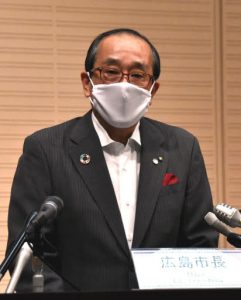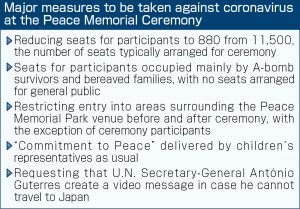Participant seating for August 6 Hiroshima Peace Memorial Ceremony to be reduced by 90 percent
May 30, 2020
by Junji Akechi, Staff Writer
On May 29, Hiroshima Mayor Kazumi Matsui announced that the Hiroshima City government would reduce the number of seats for participants in this year’s August 6 Hiroshima Peace Memorial Ceremony by 90 percent compared with previous years due to the coronavirus pandemic, limiting the seating capacity to a maximum of 880 attendees. Hiroshima City aims to avoid creating overcrowding and close contact by leaving space between seats. A-bomb survivors and bereaved families will be given priority for seating. The city government will also restrict entry into the areas surrounding the venue, except for ceremony participants, at times before and after the ceremony. On the upcoming 75th anniversary of the atomic bombing, the Hiroshima Peace Memorial Ceremony will thus be held on an exceptionally small scale.
Every year, 11,500 seats are arranged for participants on the grass square in Hiroshima Peace Memorial Park. This year, however, the city government will not set up the 4,600 seats typically available for the general public or the 3,000 for elementary and junior high school students who visit Hiroshima from throughout Japan for peace studies. Seats for the participants in this year’s peace ceremony will be placed two meters apart to prevent spread of the coronavirus, in accordance with national guidelines.
About 50,000 people visit the Peace Memorial Park for the Peace Memorial Ceremony each year, and areas surrounding the venue are particularly crowded. The city government will restrict entry into the neighborhoods around the venue before and after the ceremony, which will start at 8:00 a.m., with the aim of reducing crowds of people. The city government is expected to soon hammer out details of the times and areas subject to the restrictions. Hiroshima City said that the restrictions would not affect the different memorial services held in the Peace Memorial Park for specific city districts or middle schools.
Hiroshima City will call on Prime Minister Shinzo Abe, who attends the Peace Memorial Ceremony every year, to again participate in the ceremony this year. It also intends to invite, as usual, representatives of bereaved families from each prefecture and overseas ambassadors residing in Japan. The city government will ask U.N. Secretary-General António Guterres, who has expressed his intent to attend the ceremony, to make a video message in case he cannot travel to Japan. The “Commitment to Peace,” a message from children that is read aloud by children’s representatives, will be delivered as usual.
At the press conference, Mayor Matsui said, “With the atomic bombing experience as the starting point, Hiroshima has held the Peace Memorial Ceremony as a ceremony through which people all over the world can share Hiroshima’s feelings about the issue. While circumstances do not allow us to invite many people, we would like to make this year’s Peace Memorial Ceremony an opportunity to realize anew the significance of sending a message through the ceremony.”
The Peace Memorial Ceremony in Hiroshima began in 1947 as the Peace Festival. Against the backdrop of the Korean War, the Peace Festival in 1950 was the only ceremony to have been cancelled. In attendance at last year’s ceremony were representatives from 89 nations, including nuclear weapons states, and representatives of the European Union (EU).
(Originally published on May 30, 2020)
A-bomb survivors and bereaved families to be given priority for seating
Restriction on entry into vicinity around Peace Memorial Ceremony venue
On May 29, Hiroshima Mayor Kazumi Matsui announced that the Hiroshima City government would reduce the number of seats for participants in this year’s August 6 Hiroshima Peace Memorial Ceremony by 90 percent compared with previous years due to the coronavirus pandemic, limiting the seating capacity to a maximum of 880 attendees. Hiroshima City aims to avoid creating overcrowding and close contact by leaving space between seats. A-bomb survivors and bereaved families will be given priority for seating. The city government will also restrict entry into the areas surrounding the venue, except for ceremony participants, at times before and after the ceremony. On the upcoming 75th anniversary of the atomic bombing, the Hiroshima Peace Memorial Ceremony will thus be held on an exceptionally small scale.
Every year, 11,500 seats are arranged for participants on the grass square in Hiroshima Peace Memorial Park. This year, however, the city government will not set up the 4,600 seats typically available for the general public or the 3,000 for elementary and junior high school students who visit Hiroshima from throughout Japan for peace studies. Seats for the participants in this year’s peace ceremony will be placed two meters apart to prevent spread of the coronavirus, in accordance with national guidelines.
About 50,000 people visit the Peace Memorial Park for the Peace Memorial Ceremony each year, and areas surrounding the venue are particularly crowded. The city government will restrict entry into the neighborhoods around the venue before and after the ceremony, which will start at 8:00 a.m., with the aim of reducing crowds of people. The city government is expected to soon hammer out details of the times and areas subject to the restrictions. Hiroshima City said that the restrictions would not affect the different memorial services held in the Peace Memorial Park for specific city districts or middle schools.
Hiroshima City will call on Prime Minister Shinzo Abe, who attends the Peace Memorial Ceremony every year, to again participate in the ceremony this year. It also intends to invite, as usual, representatives of bereaved families from each prefecture and overseas ambassadors residing in Japan. The city government will ask U.N. Secretary-General António Guterres, who has expressed his intent to attend the ceremony, to make a video message in case he cannot travel to Japan. The “Commitment to Peace,” a message from children that is read aloud by children’s representatives, will be delivered as usual.
At the press conference, Mayor Matsui said, “With the atomic bombing experience as the starting point, Hiroshima has held the Peace Memorial Ceremony as a ceremony through which people all over the world can share Hiroshima’s feelings about the issue. While circumstances do not allow us to invite many people, we would like to make this year’s Peace Memorial Ceremony an opportunity to realize anew the significance of sending a message through the ceremony.”
The Peace Memorial Ceremony in Hiroshima began in 1947 as the Peace Festival. Against the backdrop of the Korean War, the Peace Festival in 1950 was the only ceremony to have been cancelled. In attendance at last year’s ceremony were representatives from 89 nations, including nuclear weapons states, and representatives of the European Union (EU).
(Originally published on May 30, 2020)









